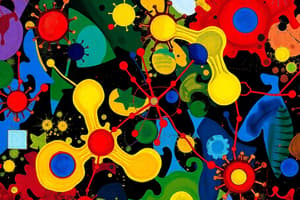Podcast
Questions and Answers
What happens to CDK activity as the cyclin associated with it is degraded?
What happens to CDK activity as the cyclin associated with it is degraded?
- CDK activity increases.
- CDK activity fluctuates randomly.
- CDK activity remains constant.
- CDK activity abates. (correct)
Which of the following cyclins appear sequentially during the cell cycle?
Which of the following cyclins appear sequentially during the cell cycle?
- Cyclins A, C, D, and E
- Cyclins X, Y, Z, and W
- Cyclins D, E, A, and B (correct)
- Cyclins D, F, G, and H
How many cyclins have been identified in relation to CDK activity?
How many cyclins have been identified in relation to CDK activity?
- Exactly 20 cyclins
- More than 15 cyclins (correct)
- Around 10 cyclins
- About 5 cyclins
In the analogy of a relay race, what does each leg represent?
In the analogy of a relay race, what does each leg represent?
What is the primary role of cyclins in relation to CDKs?
What is the primary role of cyclins in relation to CDKs?
Which type of cells are continually dividing and pass directly from M to G1?
Which type of cells are continually dividing and pass directly from M to G1?
Which type of cells has left the cell cycle and cannot undergo mitotic division?
Which type of cells has left the cell cycle and cannot undergo mitotic division?
What is the main effect of the Warburg effect on cancer cell metabolism?
What is the main effect of the Warburg effect on cancer cell metabolism?
Which of the following is an example of hypertrophy caused by increased functional demand?
Which of the following is an example of hypertrophy caused by increased functional demand?
Which mechanism is primarily responsible for protein production in hypertrophy?
Which mechanism is primarily responsible for protein production in hypertrophy?
What type of cell adaptation involves an increase in the number of cells?
What type of cell adaptation involves an increase in the number of cells?
Which cells can divide upon activation but are generally in a quiescent state?
Which cells can divide upon activation but are generally in a quiescent state?
Which of the following is NOT a type of cell adaptation?
Which of the following is NOT a type of cell adaptation?
What is the consequence of anaerobic glycolysis during ATP depletion?
What is the consequence of anaerobic glycolysis during ATP depletion?
Which process is primarily impacted due to the prolonged depletion of ATP?
Which process is primarily impacted due to the prolonged depletion of ATP?
What triggers the unfolded protein response in cells deprived of oxygen or glucose?
What triggers the unfolded protein response in cells deprived of oxygen or glucose?
What may result from irreversible mitochondrial damage following cytosolic calcium influx?
What may result from irreversible mitochondrial damage following cytosolic calcium influx?
What is the initial effect of a failure in the Ca2+ pump within cells?
What is the initial effect of a failure in the Ca2+ pump within cells?
What phase of the cell cycle follows the G1 phase?
What phase of the cell cycle follows the G1 phase?
Which protein complex is essential for cyclin-dependent kinase activity?
Which protein complex is essential for cyclin-dependent kinase activity?
In which state are quiescent cells that are not actively cycling found?
In which state are quiescent cells that are not actively cycling found?
What is the consequence of nonfidelity in DNA replication during the cell cycle?
What is the consequence of nonfidelity in DNA replication during the cell cycle?
What happens to cyclin levels during the cell cycle?
What happens to cyclin levels during the cell cycle?
Which of the following is NOT a phase of the cell cycle?
Which of the following is NOT a phase of the cell cycle?
What triggers increased CDK activity?
What triggers increased CDK activity?
Which type of cyclin is NOT mentioned as being present during the cell cycle?
Which type of cyclin is NOT mentioned as being present during the cell cycle?
Flashcards are hidden until you start studying
Study Notes
Cyclin-Dependent Kinases (CDKs)
- Phosphorylation of CDKs leads to their activation; degradation of associated cyclins reduces CDK activity.
- Cyclin levels fluctuate throughout the cell cycle, directly influencing the activity of related CDKs.
Types of Cyclins
- Over 15 different cyclins have been identified, with cyclins D, E, A, and B being the most prominent.
- Cyclins D, E, A, and B appear at specific points during the cell cycle, each binding to one or more CDKs to regulate progress.
Cell Cycle Regulation
- The cell cycle is likened to a relay race, where different cyclins regulate distinct phases.
- As one set of cyclins is degraded at the end of their phase, another set emerges to guide the next phase of the cell cycle.
Cell Metabolism and Cancer
- Aerobic glycolysis is a hallmark of cancer called the Warburg effect, resulting in reduced oxidative phosphorylation.
- Alterations in metabolic processes play a crucial role in cancer cell growth.
Cell Classification by Proliferative Potential
- Cells are categorized into three types based on their ability to proliferate: labile cells, stable cells, and permanent cells.
Labile Cells
- Continuously dividing cells; transition directly from mitosis (M) to G1 phase.
- Examples include:
- Epidermis of skin
- Surface epithelium of gastrointestinal (GI) and genitourinary (GU) systems
- Hemopoietic cells
Stable Cells
- Cells in a quiescent state (G0) that can divide when activated.
- Examples include:
- Hepatocytes
- Renal tubular cells
- Glandular cells
- Mesenchymal cells (e.g., smooth muscle)
Permanent Cells
- Cells that have exited the cell cycle and cannot undergo mitotic division.
- Examples include:
- Neurons
- Cardiac muscle cells
- Skeletal muscle cells
Types of Cell Adaptations
- Atrophy: Decrease in cell size.
- Hypertrophy: Increase in cell size.
- Hyperplasia: Increase in cell number.
- Metaplasia: Change in cell type.
Hypertrophy
- Defined as an increase in the size of parenchymal cells, leading to organ enlargement.
- Involves increased protein synthesis and not necessarily pathological conditions.
- Causes include:
- Increased functional demand (e.g., uterus during pregnancy).
- Hormonal and growth factor stimulation.
- Enhanced protein synthesis or reduced breakdown.
Mechanisms of Hypertrophy
- Enhanced cellular protein production due to increased gene activation.
- Selective hypertrophy of organelles, e.g., barbiturate use leads to smooth endoplasmic reticulum hypertrophy in hepatocytes.
Cellular Injury Mechanisms
- Failure of Ca2+ pump leads to calcium influx, damaging various cellular components.
- Structural disruption of protein synthesis apparatus due to ATP depletion; may result in ribosome detachment from rough endoplasmic reticulum.
- Oxygen or glucose deprivation can cause misfolded proteins, triggering the unfolded protein response, resulting in cellular injury or death.
Mitochondrial Damage
- Damage to mitochondria can occur due to elevated cytosolic Ca2+, oxidative stress, or phospholipid breakdown.
- High-conductance channels form in the inner mitochondrial membrane, which can lead to irreversible injury if persistence occurs.
Calcium Homeostasis
- Cytosolic free calcium maintained at low levels is essential for normal cellular function.
Cell Proliferation Importance
- Fundamental for organism development and tissue homeostasis.
- Involves accurate DNA replication and equal distribution of cellular components during cell division.
Cell Cycle Phases
- Comprised of G1 (gap 1), S (DNA synthesis), G2 (gap 2), and M (mitotic) phases.
- Quiescent cells in G0 can re-enter G1 after mitosis.
- Cell cycle progression regulated by activators and inhibitors.
Cell Cycle Regulation
- Chaperoned by cyclins and cyclin-dependent kinases (CDKs).
- Cyclins cyclically produced and degraded, regulating CDK activity.
- More than 15 cyclins identified, with D, E, A, and B participating sequentially during the cycle.
Studying That Suits You
Use AI to generate personalized quizzes and flashcards to suit your learning preferences.



